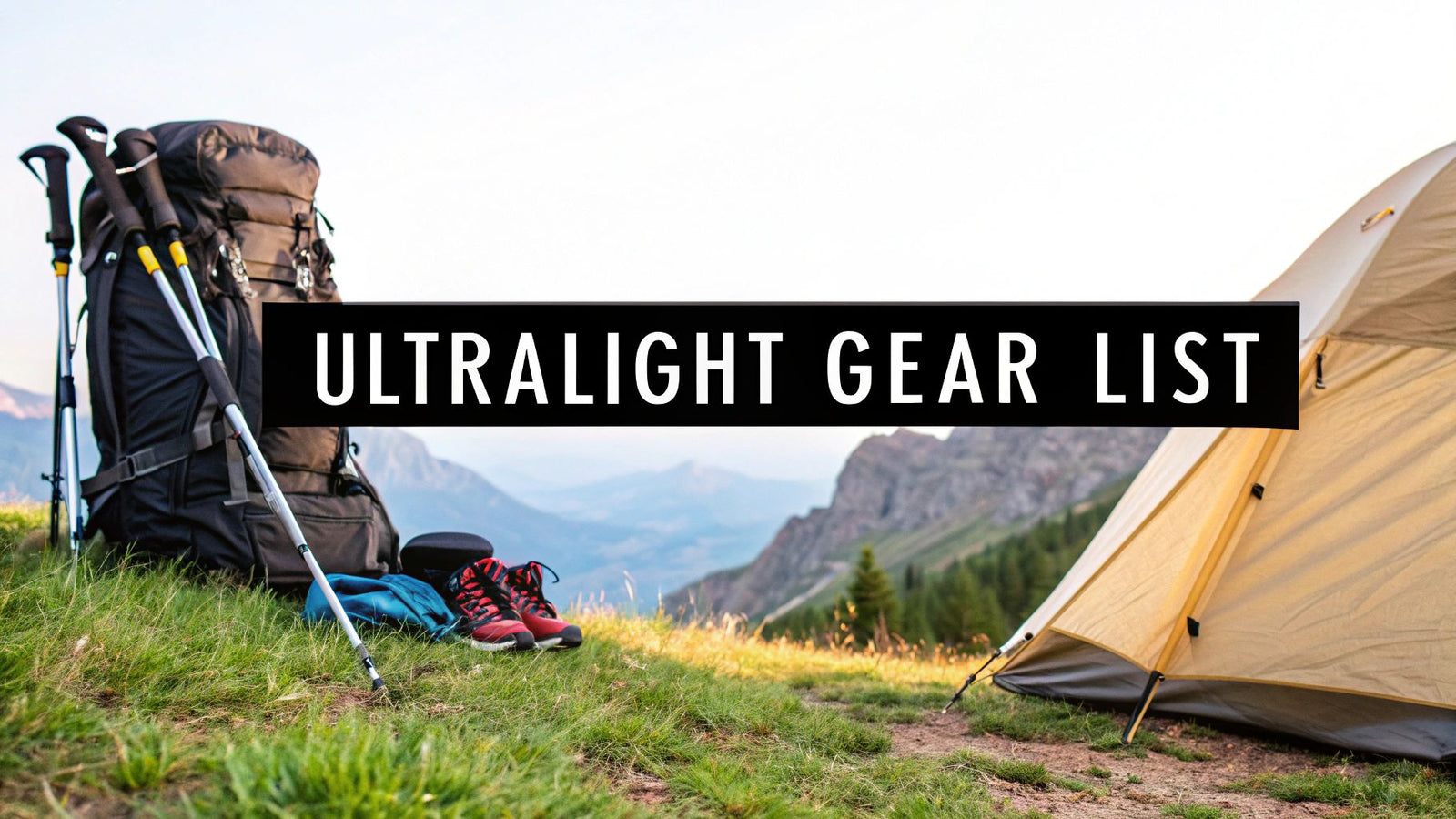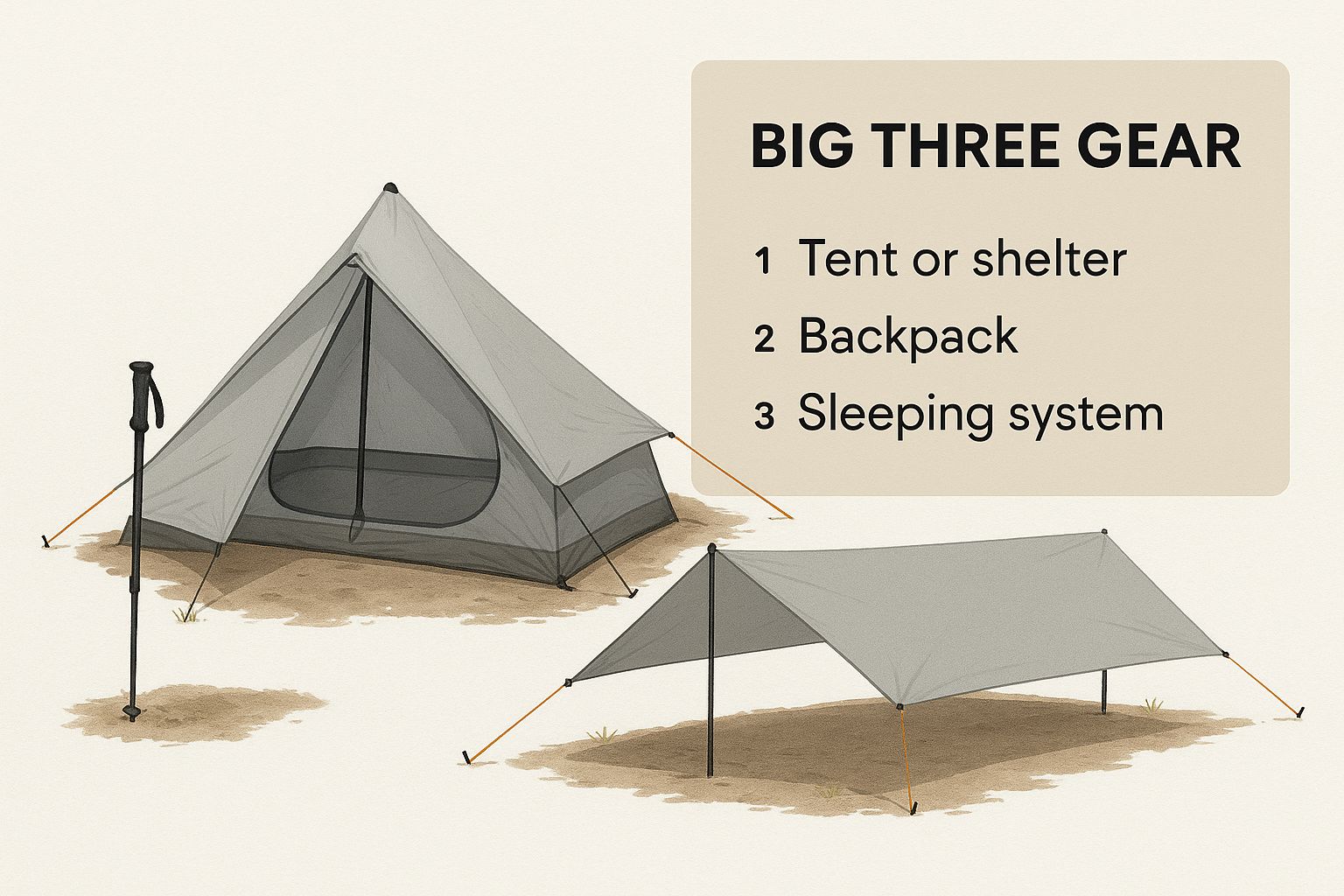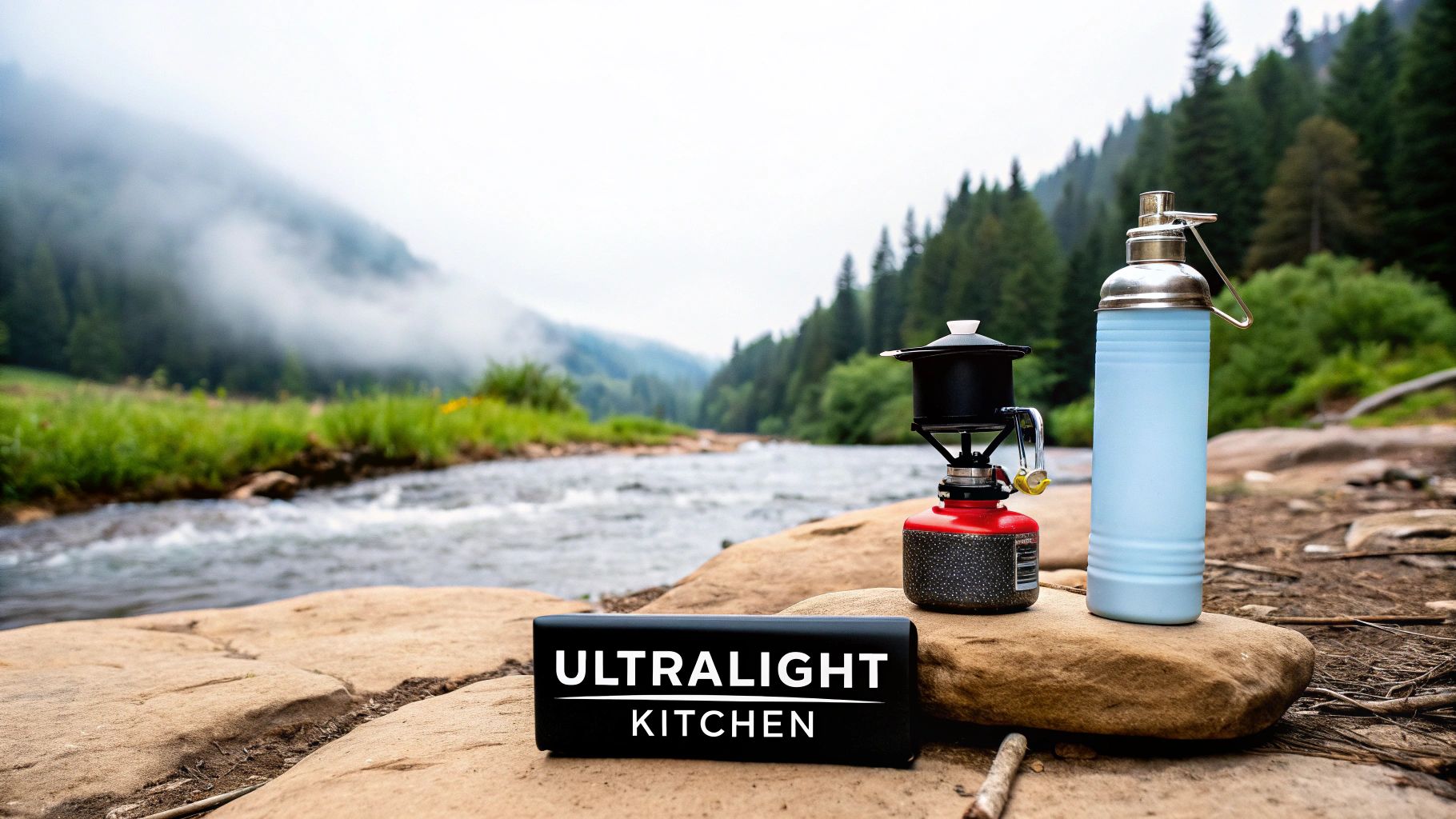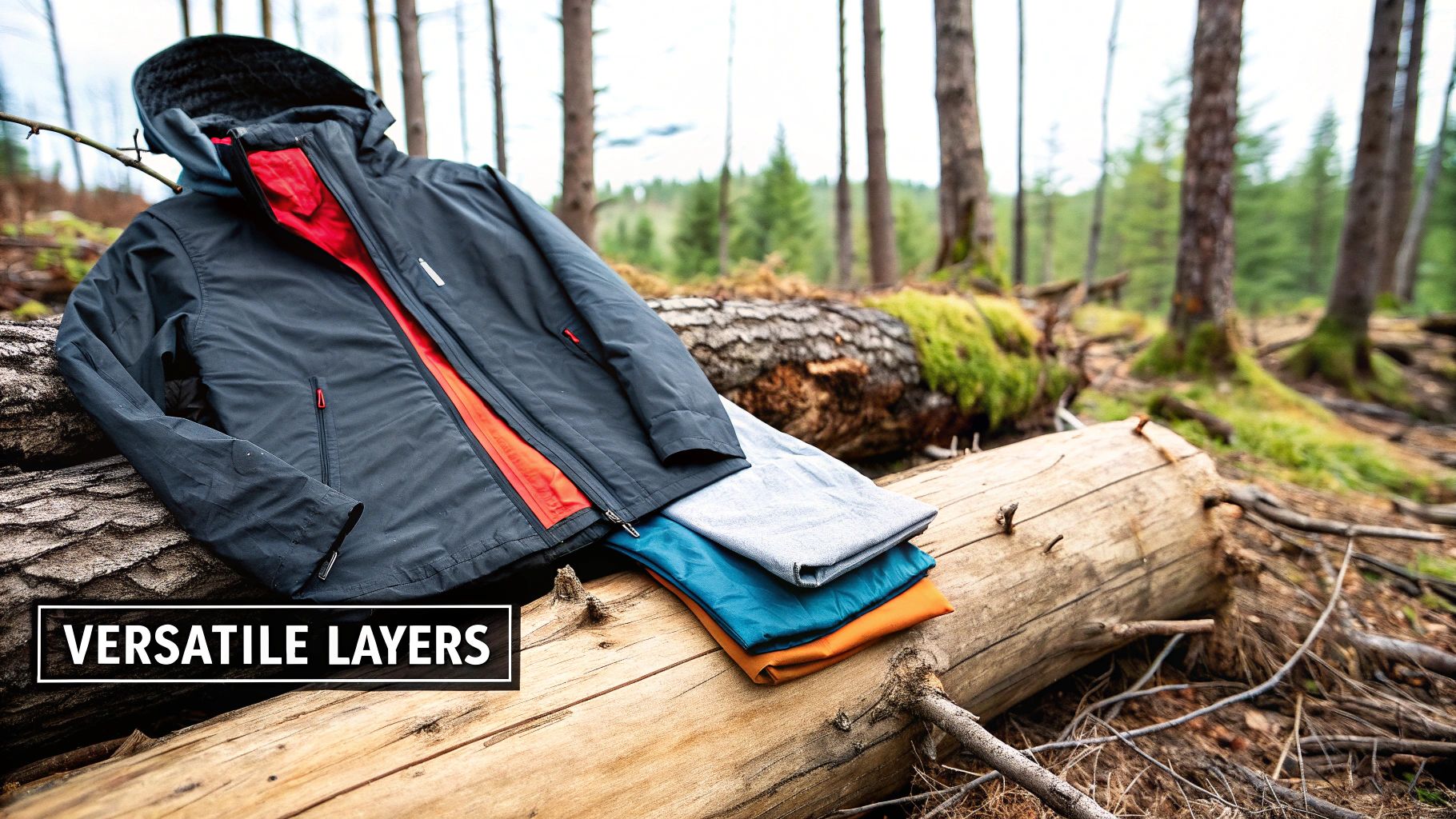Your Ultralight Camping Gear list for Thru-Hiking

Building a complete ultralight camping kit starts with a single, challenging goal: a base weight of 10 pounds or less. This doesn't include consumables like your food, water, and fuel. Getting there isn't just about buying fancy gear; it's about a total mindset shift away from packing "just in case" items and focusing only on what is absolutely essential for your safety and comfort on the trail.
Adopting the Ultralight Thru-Hiking Mindset
Before you spend a single dollar on new equipment, the first and most important step is to really embrace the ultralight philosophy. It’s less about obsessing over titanium sporks and more about fundamentally changing how you think about your needs out on the trail. This shift—from a "what if?" packer to a "what do I truly need?" minimalist—is the foundation of every successful ultralight kit.
This mental adjustment has a massive impact on your physical experience. Trust me. Carrying less weight means less strain on your knees and back, more energy for those steep ascents, and the freedom to cover more ground each day. For example, instead of struggling up a pass on the John Muir Trail feeling every ounce, a lighter pack lets you enjoy the stunning Sierra Nevada views. A trek that might have been grueling can transform into a genuinely enjoyable journey.
From 'Just in Case' to 'Just Enough'
The old way of thinking led me to pack things like a heavy camp chair and a bulky multi-tool I never even touched. The new approach forces you to put every single item on trial.
Ask yourself these questions for everything you consider packing:
- Can this item serve more than one purpose? (Think a bandana as a pot holder, towel, and filter).
- Is there a lighter alternative available? (For example, can your trekking pole also serve as your tent pole?)
- What is the realistic consequence of not having this?
This critical evaluation is how you build an efficient, dialed-in gear list. It’s all about being prepared, not over-prepared. The goal isn’t to suffer, but to find that perfect balance where you have everything you need for a safe trip, and absolutely nothing more.
Sustainability and Innovation in Modern Gear
Thankfully, adopting this mindset is easier now than ever before. The ultralight outdoor gear scene is exploding with incredible innovations in materials and a growing demand for sustainable products.
Today's gear isn't just lighter; it's often more durable and eco-friendly. Brands are pushing the envelope with advanced recycled fabrics and clever multi-functional items that reduce both your pack weight and your environmental impact.
This move toward sustainability is a huge part of the modern thru-hiking mindset. For example, using a HYDAWAY collapsible bottle for your water completely eliminates the need for single-use plastic bottles, which often end up as trail litter. It’s a practical way to live out the "Leave No Trace" principle, saving space in your pack and reducing waste. When it's empty, it squishes down to an inch thick, freeing up valuable room for other essentials. If you're looking for more ideas, we've got a great guide on how to reduce plastic waste on your adventures.
Ready to put that new ultralight mindset to the test? There's no better way than by planning a trip. You might want to check out some of these epic Tasmania multi-day hikes for some serious inspiration.
Choosing Your Ultralight Big Three
Your journey into building a killer ultralight camping kit all starts with what we call the “Big Three.” This isn't just a catchy phrase; it's the absolute foundation of your pack. We're talking about your shelter, your sleep system (that’s your sleeping bag or quilt plus your pad), and your backpack itself.
These are, without a doubt, the heaviest things you'll carry. That means they're also your biggest opportunity to slash serious weight from your back. Nailing these three core pieces is how you build a comfortable, fast, and efficient ultralight setup.
Making smart choices here is about more than just cutting pounds; it sets off a chain reaction. A lighter tent and sleep system mean you can get away with a smaller, lighter backpack. This synergy is where the ultralight magic really kicks in, completely changing how you feel on the trail.
This infographic gives you a quick visual breakdown of the Big Three, showing how traditional gear stacks up against the ultralight alternatives.

As you can see, the difference between a typical backpacking tent and a minimalist tarp, or a mummy bag and a quilt, can easily add up to several pounds. That's weight you won't have to haul up the next climb, directly boosting your comfort and letting you cover more ground.
When it comes to your "Big Three," the weight savings are dramatic. Swapping out conventional gear for ultralight alternatives can easily shave 5-10 pounds off your base weight. Let's look at a quick comparison to see where that weight comes from.
Ultralight 'Big Three' Comparison
| Category | Conventional Gear (Example) | Ultralight Alternative (Example) | Typical Weight Savings |
|---|---|---|---|
| Shelter | Freestanding 2P Tent (e.g., REI Half Dome) | Tarp & Bivy or Trekking Pole Tent (e.g., Zpacks Duplex) | 2 - 4 lbs |
| Sleep System | Synthetic Mummy Bag & Foam Pad | Down Quilt & Inflatable Pad (e.g., Enlightened Equipment Quilt) | 1.5 - 3 lbs |
| Backpack | Internal Frame Pack (60-70L) | Frameless Pack (40-50L) (e.g., Pa'lante V2) | 2 - 4 lbs |
As the table shows, each component offers a significant reduction on its own. Together, they form the core of a truly lightweight system, making your time on the trail far more enjoyable.
Selecting Your Ultralight Shelter
Your choice of shelter is deeply tied to where you'll be hiking. Out on the relatively dry and wide-open Pacific Crest Trail, a trekking pole tent like the Zpacks Duplex is an incredible choice. It brilliantly uses the poles you're already carrying to pitch a roomy shelter that weighs less than two pounds.
But if you’re heading for the notoriously wet and buggy Appalachian Trail, a simple tarp might not cut it. You'd be miserable. In that scenario, the extra few ounces for a fully enclosed tent is a small price to pay for your sanity and a good night's sleep.
The Sleep System Quilt vs Bag
For your sleep system, the big debate is often a quilt versus a classic mummy bag. A quilt, like the fantastic Feathered Friends Flicker UL, gets rid of the insulation underneath your body—which gets compressed and becomes useless anyway—saving a ton of weight and pack space. It’s designed to work directly with your sleeping pad, creating one cohesive system.
The most critical piece of this puzzle is your sleeping pad's R-value, which is its ability to insulate you from the cold ground. For three-season hiking, a high R-value pad (4.0 or higher) is non-negotiable. It's what keeps you warm, and a quilt is useless without it.
Finding the Right Ultralight Backpack
Finally, the backpack is what holds it all together. A modern frameless pack, like the popular Hyperlite Mountain Gear Southwest 2400, can weigh just around two pounds. But there's a catch: they're built to comfortably carry a total pack weight of 20-30 pounds.
This is exactly why you have to pick your other Big Three items first. Your final base weight dictates which pack is right for you.
Overload a frameless pack, and you're in for a world of hurt. But load it correctly, and it feels like an extension of your own body, letting you move with agility and grace on the trail. Just like any major purchase, knowing the key features of gear is crucial. By carefully choosing these three items to work together, you'll build the strong, lightweight foundation your whole kit depends on.
Your Ultralight Kitchen and Hydration System
Food and water are non-negotiables out on the trail, but the gear you use to prepare and carry them doesn't need to feel like a boat anchor in your pack. Dialing in an efficient kitchen and hydration system is a core part of any successful ultralight setup, where every single gram and every inch of space counts.

On a recent weekend trip, I finally ditched my bulky canister stove for a tiny Esbit solid fuel stove. The difference was incredible. My entire cook kit now fits in the palm of my hand, perfect for boiling water for a dehydrated meal or a morning coffee without hauling a heavy metal canister.
Smart Cooking Solutions
Your cooking style on the trail really dictates your gear choices. Are you a gourmet backcountry chef, or are you more of a "just add hot water" kind of hiker?
- Hot Meals: If you can't live without a hot meal, a minimalist stove is essential. The BRS-3000T stove—weighing less than an ounce—paired with a small titanium pot like the TOAKS 450ml is a classic ultralight combo. This kind of setup lets you boil water quickly for your morning oatmeal and get back to hiking.
- Cold Soaking: To drop even more weight, especially in warmer weather, cold-soaking is a total game-changer. You just rehydrate meals like couscous, ramen, or mashed potatoes in a sealed container for about an hour before you plan to eat. A simple screw-top plastic jar works perfectly for this.
This minimalist approach strips away all the unnecessary bits and pieces, leaving you with only what you need to fuel your adventure. It’s about being smart, not about being deprived.
Rethinking Hydration on the Trail
Hydration is another area just begging for weight savings. Those bulky, heavy water bladders are often overkill and a real pain to refill on the go. A simpler, lighter, and more adaptable system is the way to go.
The gold standard for ultralight hikers is a Sawyer Squeeze water filter paired with a couple of disposable plastic water bottles (like Smartwater bottles). This system is incredibly effective. One bottle is your "dirty" water collector, which you then squeeze through the filter into your "clean" bottle. It's fast, reliable, and weighs just a few ounces.
This is where multi-use gear truly shines. A product like the HYDAWAY 25oz collapsible bottle fits perfectly into this system. You can use it as your dedicated "dirty" water bag for filtering at a stream, and once you've filled your clean bottles, it collapses down to just over an inch. This means it takes up virtually no space in your pack, unlike a rigid bottle.
This kind of functionality is the very essence of ultralight thinking. It serves a primary purpose effectively and then disappears when you don't need it.
For more ideas on efficient water storage, check out our complete guide on collapsible water containers for camping. Your kitchen and hydration setup should support your hike, not weigh you down.
Building a Versatile Clothing System
Your clothing is your first line of defense out there—think of it as a mobile shelter that keeps you warm, dry, and protected from whatever the trail throws at you. It’s also, without a doubt, one of the easiest places to accidentally pack way too much weight.
The secret is building a smart, multi-functional layering system. This is what keeps you comfortable in changing conditions without forcing you to haul a bunch of single-purpose items up a mountain.

Ultimately, the goal is to create a clothing list that can handle a chilly morning, a sun-baked afternoon, and an unexpected storm with just a handful of versatile pieces. Remember, what you wear is just as important as what you carry.
The Core Layering Principles
The entire foundation of a solid ultralight clothing system is layering. It’s a simple concept. Instead of one big, heavy jacket, you combine several lighter layers that you can add or shed as your activity level and the weather change. This gives you a massive amount of flexibility.
The system really boils down to three key parts:
- Base Layer: This is what’s right against your skin. Its whole job is to wick moisture away to help regulate your body temperature. Merino wool is a fan favorite for good reason—it’s naturally odor-resistant and still performs well even when damp.
- Mid Layer: This is your active insulation. A lightweight fleece or a modern "active-insulation" piece like the Patagonia R1 Air provides warmth but stays breathable, which is perfect for hiking on cool days.
- Shell Layer: Your outer layer is your shield against wind and rain. A high-quality, lightweight rain shell is absolutely non-negotiable. It’s what keeps your other layers dry and doing their job.
Multi-Functional Gear is Key
Every single piece of clothing you decide to pack should be put under a microscope and asked one question: can it do more than one thing? This mindset is what truly starts shaving ounces—and even pounds—off your gear list.
A simple Buff or neck gaiter, for example, is a powerhouse of utility. It can be a hat, a headband, a neck warmer, a sun shield for your face, and I've even seen people use one as a rough pre-filter for silty water in a pinch.
Likewise, your puffy insulated jacket is essential for staying warm at camp, but it can also be stuffed into its own pocket or a stuff sack to become a surprisingly comfortable pillow at night.
By selecting items that pull double-duty, you eliminate redundant gear. This not only lightens your load but also simplifies your entire system, making packing and decision-making on the trail much faster.
Innovations in textiles are making a huge difference here, too. The constant push for lighter, more efficient materials is completely changing what’s possible in outdoor apparel. We're seeing new fabrics that offer incredible warmth-to-weight ratios without sacrificing durability, making our gear more effective than ever. You can see how new materials are changing the game by reading about the latest trends in ultralight outdoor gear at Adventure Alan. This focus on efficiency means your clothing system can be lighter and more capable than you might think.
Dialing In Your Miscellaneous Gear
This is where a truly great ultralight camping gear list is made. You can find massive weight savings in your Big Three and clothing system, sure, but it’s the small, miscellaneous items that sneakily add ounces and turn them into pounds. Looking closely at your electronics, first-aid kit, and toiletries is what separates a good list from a great one.
Think about it this way: your smartphone is already a powerful GPS, a fantastic camera, a notebook, and even a headlamp if you’re in a bind. Why carry separate gadgets for each of those jobs? A modern smartphone, paired with a tiny, featherlight power bank like the Nitecore NB10000, can easily get you through a multi-day trip while keeping you safe and connected.
Personalizing Your First-Aid and Toiletries
One of the easiest places to shed weight is by ditching that bulky, pre-packaged first-aid kit you bought at the store. Honestly, most of what’s inside isn't necessary for a typical backpacking trip. The smarter move is to build your own kit based on what you actually need and how long you'll be out.
Here’s a practical, bare-bones setup to start with:
- A few fabric bandages in assorted sizes for small cuts.
- Small squares of moleskin or Leukotape for tackling hot spots before they become blisters.
- A couple of antiseptic wipes and single-use antibiotic ointment packets.
- A small handful of your go-to pain reliever (ibuprofen, etc.).
- Miniature scissors or the tiny blade on a micro-knife for cutting tape.
Just toss these items into a tiny Ziploc bag. This trick saves a surprising amount of weight and space, and you’ll know you have exactly what you need without any of the extra fluff. For toiletries, decant everything. A contact lens case is a brilliant hack for holding a few nights' worth of toothpaste and sunscreen.
Smart Choices for Essential Tools
Every single tool in your pack deserves a second look. Instead of that heavy multi-tool, you’ll probably find that a tiny pair of scissors and a micro-knife are more than enough for most trail tasks. For your light source, a minimalist, USB-rechargeable headlamp like the Nitecore NU25 gives you all the light you need for camp chores and weighs just over an ounce.
The name of the game here is multi-functionality and ruthless efficiency. Always ask yourself: Can one item do the job of two? Can I find a smaller, lighter version that does the same thing? This is how you win back those precious ounces from your pack.
This ultralight mindset is catching on, and the market shows it. More people than ever are looking for lightweight, efficient gear for their outdoor trips. All this growth means more innovative options for hikers like us. You can discover more insights about camping gear trends on accio.com.
Finally, don’t forget your kitchen gear. A rigid bowl for rehydrating your dinner adds unnecessary bulk and takes up awkward space. This is the perfect place for a HYDAWAY collapsible bowl. It’s sturdy enough to handle a hot meal but collapses down completely flat when you’re done, letting you slide it into any tiny gap left in your pack. Our guide on collapsible silicone food containers shows just how this simple swap embodies the ultralight spirit—saving space and weight without giving up function.
Answering Your Biggest Ultralight Questions
Diving into the world of ultralight backpacking always brings up a few solid questions. Let's walk through some of the most common hurdles people face when they're trying to trim down their first ultralight camping gear list.
Getting these things straight from the get-go will help you build your kit with way more confidence.
Is Ultralight Gear Less Durable?
This is probably the biggest myth out there, and the short answer is: not really. Modern materials like Dyneema Composite Fabric (DCF) and today's advanced ripstop nylons are engineered to be incredibly tough for their weight. Think of it less as "flimsy" and more as "highly specialized."
Honestly, durability often has more to do with how you treat your gear than how much it weighs. A 1-pound DCF tent will hold up beautifully if you pitch it correctly, but it’s not going to survive being dragged over a field of sharp rocks. The real key is picking the right tool for the job—and using it with a bit of care.
How Do You Handle Food in Bear Country?
Going ultralight absolutely does not mean being unsafe. It just means your food storage strategy needs to be as smart and weight-conscious as the rest of your kit. Those big, bulky hard-sided bear canisters aren't your only choice, though some parks do require them.
Here are a few lighter, smarter options:
- Bear-Resistant Sacks: Something like an Ursack Major, made from bulletproof fabric, is a fantastic alternative that weighs a fraction of a traditional canister.
- Lightweight Canisters: If a canister is mandatory, brands like BearVault have models that are much lighter than the old-school versions.
- Smart Food Planning: The best strategy of all is simply minimizing your food's weight and volume from the start. Plan your meals down to the calorie so you're not stuck carrying—and protecting—extra weight.
Do I Have to Spend a Fortune?
Nope, definitely not. While the top-shelf, big-name gear can have some eye-watering price tags, the ultralight mindset is fundamentally about carrying less, not just buying lighter. The single most effective way to drop pack weight is completely free: just leave stuff you don't need at home.
The core principle is efficiency. You can save pounds by modifying the gear you already own, choosing budget-friendly cottage industry brands, or focusing on multi-use items. Going ultralight is a skill, not a shopping spree.
For example, a HYDAWAY collapsible bottle handles all your hydration needs on the trail and then squishes down to almost nothing. It's a practical, affordable choice that fits perfectly into an ultralight kit, saving you space and eliminating the waste of single-use bottles without the high cost of specialized gear. It's a smart upgrade that delivers real value.
Ready to gear up for your next adventure with smart, space-saving essentials? Explore the full collection of collapsible, ultra-portable gear from HYDAWAY and see just how much lighter your pack can be. Start building your perfect kit at myhydaway.com.



